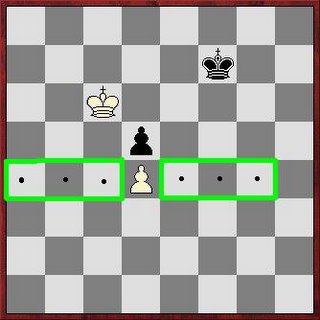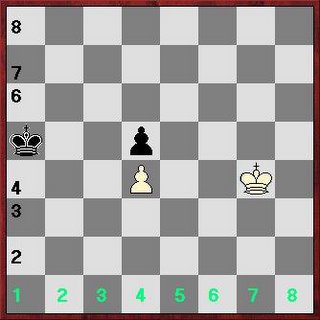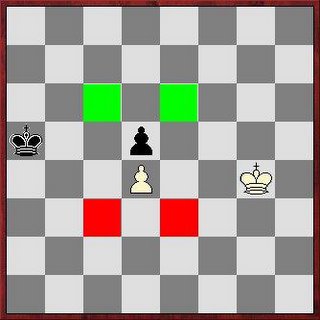Basic pawn endings: blocked pawns 2 - no rook pawns
First issue the "Critical" squares of blocked pawns.
The Critical squares are those squares occupied by an attacking king which automatically leads to a win. In our case to the irrevocable loss of the pawn (= the reduction of a K+P versus K+P ending to a K+P versus K ending) but NOT necessarily to the outcome of the game. When the attacking King can reach such square a forced sequence follows which ends with the capture of the pawn.

Diagram 1 ( 6 critical squares for the white pawn on the rank of the black enemy pawn)

Diagram 2 ( 6 critical squares for the black pawn on the rank of the white enemy pawn)
Diagram 1- 2 The position of both Kings are not important for now.
Second issue: How can you easily calculate the amount of moves your King has to make to reach a certain square?
When I started to play chess I always made a lot of calculations errors, especially concerning K-moves. For instance I calculated that my opponent need to make 5 moves with his K to come to the stunning conclusion that I made a mistake. I know that some people visualizes and moves both kings over the board to obtain a similar position. This doesn't work for me. Not always anyway.
So my comfort in the 64 square board lies in the number 64, 8x8. One day I came to the stunning conclusion that I just replace the letters by numbers and pure maths on it. So If my King has to move from let's say g-file (7) to the b-file (2) I know he neads 5 moves (7-2) and not 6 or 4.
This simple fact was quite a revelation for me and If you apply the square of the rule to the King(which one normally uses for passed pawns to see whether the enemy king can intercept the pawn or not) you will see what territory your King can cover within those 5 moves.
The same holds for pawns but be aware a pawn on the second rank can do two-steps. So the pawn needs at least 5 moves to reach the last rank (8-3), your king 6 (8-2)!

Third issue: Behind enemy lines, reaching the red or green square

If you can reach the red or green square without loss of your own pawn, you have reached the critical square behind enemy lines.
In the above example white needs 2 moves to its nearest green square, black 2 moves to its nearest red square. So white to play, and on the 3rd move the black pawn will fall.
If Black decides to go the red square his king will be on the wrong side of the board and white's pawn will have a free run there is no other option than trying to take the opposition on the 3rd move, on the move following the capturing of the pawn.
How to judge?
1. Is my pawn directly threatened by the king or not (distance King Pawn)? (7-4=3;4-1=3)
2. What is the position of both kings on critical squares or not? (not on critical squares)
3. How many moves do both kings need to their respective red-green squares? (2;2)
4. Are both kings on the same or opposite side of the blockaded pawns? (opposite, opposition to invade is not necessary)
5. How far is the defending King to the opposition square? (3 for black)
6. Which king has the move? (white for instance)
7. If both Kings are on the same side, opposition will play a crucial roll whether the attacking king can invade or not.
The Critical squares are those squares occupied by an attacking king which automatically leads to a win. In our case to the irrevocable loss of the pawn (= the reduction of a K+P versus K+P ending to a K+P versus K ending) but NOT necessarily to the outcome of the game. When the attacking King can reach such square a forced sequence follows which ends with the capture of the pawn.

Diagram 1 ( 6 critical squares for the white pawn on the rank of the black enemy pawn)

Diagram 2 ( 6 critical squares for the black pawn on the rank of the white enemy pawn)
Diagram 1- 2 The position of both Kings are not important for now.
Second issue: How can you easily calculate the amount of moves your King has to make to reach a certain square?
When I started to play chess I always made a lot of calculations errors, especially concerning K-moves. For instance I calculated that my opponent need to make 5 moves with his K to come to the stunning conclusion that I made a mistake. I know that some people visualizes and moves both kings over the board to obtain a similar position. This doesn't work for me. Not always anyway.
So my comfort in the 64 square board lies in the number 64, 8x8. One day I came to the stunning conclusion that I just replace the letters by numbers and pure maths on it. So If my King has to move from let's say g-file (7) to the b-file (2) I know he neads 5 moves (7-2) and not 6 or 4.
This simple fact was quite a revelation for me and If you apply the square of the rule to the King(which one normally uses for passed pawns to see whether the enemy king can intercept the pawn or not) you will see what territory your King can cover within those 5 moves.
The same holds for pawns but be aware a pawn on the second rank can do two-steps. So the pawn needs at least 5 moves to reach the last rank (8-3), your king 6 (8-2)!

Third issue: Behind enemy lines, reaching the red or green square

If you can reach the red or green square without loss of your own pawn, you have reached the critical square behind enemy lines.
In the above example white needs 2 moves to its nearest green square, black 2 moves to its nearest red square. So white to play, and on the 3rd move the black pawn will fall.
If Black decides to go the red square his king will be on the wrong side of the board and white's pawn will have a free run there is no other option than trying to take the opposition on the 3rd move, on the move following the capturing of the pawn.
How to judge?
1. Is my pawn directly threatened by the king or not (distance King Pawn)? (7-4=3;4-1=3)
2. What is the position of both kings on critical squares or not? (not on critical squares)
3. How many moves do both kings need to their respective red-green squares? (2;2)
4. Are both kings on the same or opposite side of the blockaded pawns? (opposite, opposition to invade is not necessary)
5. How far is the defending King to the opposition square? (3 for black)
6. Which king has the move? (white for instance)
7. If both Kings are on the same side, opposition will play a crucial roll whether the attacking king can invade or not.


0 Comments:
Post a Comment
<< Home